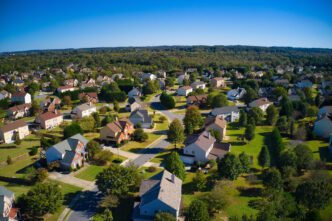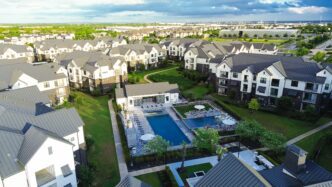Amidst the growing trend of technological advancements, the concept of 3D printed homes is becoming a reality, especially in a newly formed neighborhood in Texas. Daniella Glaeze and her husband, both tech enthusiasts, have embraced this innovation by moving into one of these uniquely constructed residences.
Daniella Glaeze is no stranger to the limelight, having shared her experiences living in a 3D printed home on TikTok. Her posts have garnered millions of views, underscoring the curiosity and intrigue surrounding these futuristic dwellings. The homes are crafted using a Vulcan Construction System, a large-scale 3D printer that creates structures from ‘lavacrete,’ a specially formulated concrete material.
The community, known as Wolf Ranch, is a product of collaboration between Icon, a 3D printing construction startup, and Lennar, a major player in home construction. Situated just north of Austin, this development comprises 100 homes, each boasting unique architectural features like biophilic designs and energy-efficient attributes. As of July, 95 homes had their wall systems printed, with full completion anticipated by 2025.
Glaeze cites her favorite aspect of residing in a 3D printed home as its aesthetic appeal. The dwellings are designed with curved walls and organic shapes, creating a seamless and visually appealing environment. Despite initial concerns from viewers about dust accumulation on the ribbed walls, Glaeze assures that maintenance is straightforward, with dust being virtually unnoticeable.

In terms of practicality, these homes offer several advantages. The thick lavacrete walls provide excellent insulation against the Texan heat and noise from outside. Residents, including Glaeze, have noted a marked difference in soundproofing compared to traditional homes. However, she did encounter some issues with WiFi connectivity due to the thick walls, though this was easily remedied with a booster.
The neighborhood’s pricing reflects the current market, with homes ranging from approximately $489,000 to $508,890. Despite the costs being on par with conventional homes, residents benefit from lower utility bills and lifecycle costs due to the energy efficiency of the 3D printed structures.
Glaeze emphasizes the innovative aspect of these homes, highlighting how they allow for architectural freedom that is both cost-effective and sustainable. Icon, alongside architecture firm Bjarke Ingels Group, has leaned into this by incorporating more organic, biophilic designs. These designs not only offer aesthetic benefits but also structural resilience, having been tested against conditions such as hurricane-force winds.
As an emerging technology, 3D printed homes promise potential cost savings and faster construction times. Icon’s Vulcan printer enables wall systems to be produced in approximately two weeks, significantly reducing labor requirements. The company’s ambitions align with tackling broader issues like the housing crisis by providing affordable, efficient housing solutions.
Despite some growing pains, such as cell service issues, Glaeze remains positive about her decision, stating that the unique living experience and the benefits of her home outweigh the challenges. The community continues to grow, attracting more like-minded individuals who are eager to explore this new frontier in housing.
Living in a 3D printed house presents a blend of modern innovation and practicality. For residents like Daniella Glaeze, the allure lies not only in the distinct design and structure but also in the promise of a more sustainable and cost-effective approach to housing. As this community evolves, it serves as a testament to the possibilities that 3D printing technology holds for the future of residential construction.
Source: Businessinsider








